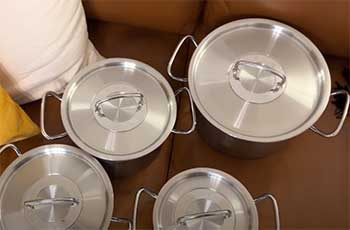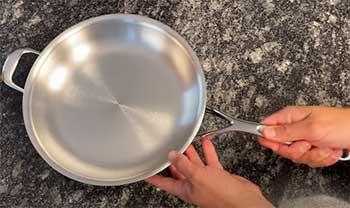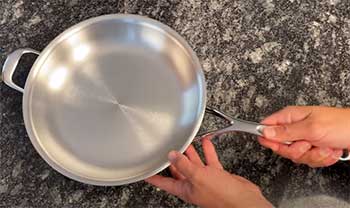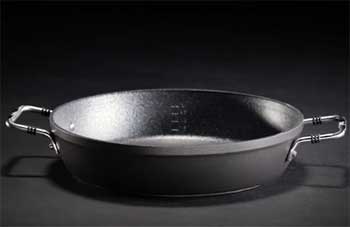When it comes to premium cookware, two brands stand out from the crowd: Fissler and Demeyere. Both are well-known for their high-quality pots and pans that professionals and home cooks alike swear by.
But with price tags starting around $100 per piece, deciding between Fissler and Demeyere requires some careful consideration.
This in-depth comparison looks at the key features and differences between Fissler and Demeyere cookware to help you determine which is better suited for your cooking needs and budget.
We’ll examine their materials and construction, heating performance, ease of use, durability and maintenance requirements. By the end, you’ll have a clear sense of their pros and cons to make an informed decision for your kitchen.
A Brief Comparison Table
| Feature | Fissler | Demeyere |
| Construction | 3-ply (stainless steel + aluminum core) | 5-ply (stainless steel + extra thick aluminum core) |
| Thickness | 2.5mm | 4.8mm |
| Durability | Very good | Excellent |
| Heat Conductivity | Good | Excellent |
| Heat Distribution | Good | Excellent |
| Handles | Ergonomic, arched | Straight, lever-style |
| Weight | Lighter | Heavier |
| Non-Stick Coating | PFOA-free ceramic (Starfri) | Stainless steel with Silvinox |
| Oven Safe Temp | Up to 500°F | Up to 500°F |
| Warranty | Lifetime | Lifetime |
Overview of Fissler
Founded in 1845 and headquartered in Germany, Fissler is one of the leading cookware brands in Europe. Their pans combine design and functionality for serious home cooks. Key features include:

- Materials: 18/10 stainless steel with an aluminum core for even heat distribution
- Oven and dishwasher safe
- Compatible with all stovetops including induction
- Ergonomic handles that stay cool
- Tight-fitting lids
- Lifetime warranty
Fissler cookware spans various product lines including Original Pro, Edition, Crispy and Protect.
Their non-stick offerings use a PTFE- and PFOA-free ceramic coating called Starfri. Prices range from around $100 up to $400 for specialty items.
Overview of Demeyere
Based in Belgium and founded in 1908, Demeyere produces professional-grade cookware for home kitchens. Their products are known for durability and distributing heat evenly. Key features include:
- Materials: Surgical stainless steel with a 5-ply construction and aluminum-alloy core
- Oven and dishwasher safe
- Compatible with all stovetops including induction
- Riveted stay-cool handles
- Tight-fitting lids
- Silvinox treatment on certain products for enhanced non-stick performance
- Lifetime warranty
The main lines from Demeyere include Proline, Atlantis, Industry5, and Resto. Their specialty non-stick coating called Surfaced 7 layers aluminum between layers of stainless steel. Prices range from $100 to $500+ for their top-tier collections.
Key Differences Between Fissler And Demeyere Cookware Brands

- Materials and Construction
The materials used in cookware play a big role in determining its heating properties, durability, and ease of maintenance. This is where we start seeing some important differences emerge between Fissler and Demeyere.
Fissler
Their Original Pro line uses 18/10 stainless steel which contains 18% chromium for corrosion resistance and 10% nickel for durability. This steel surrounds an aluminum core that extends up the sides for even heat distribution.
The aluminum core is essential for conductive cooking performance. While stainless steel alone is poor at conducting heat, the aluminum core provides efficient and uniform heating. This layered material construction is key for Fissler’s cooking ability.
For their non-stick cookware, Fissler uses a ceramic-based coating called Starfri that is PFOA free. This coating is applied to the same 18/10 stainless steel and aluminum core combination described above.
Demeyere

The primary construction Demeyere uses is called 5-ply.
This contains a thick 2.5 mm aluminum-alloy core sandwiched between 2 layers of surgical stainless steel on both the interior and exterior.
The total thickness is 4.8mm.
This specialized 5-ply material is exclusive to Demeyere and offers superior heat distribution compared to typical tri-ply options. The thick aluminum core also extends partially up the sides for more even cooking.
For non-stick surfaces, Demeyere uses their patented Surfaced stainless steel with Silvinox treatment. This electrochemical process removes iron from the stainless steel surface, leaving a thin layer of nickel and making it more resistant to sticking.
Durability Comparison
Both Fissler and Demeyere construct their cookware to last, but Demeyere’s tends to be more robust and resistant to warping. The 5-ply material is thicker and heavier than Fissler’s, making their pots and pans very durable and able to withstand high heat. This comes at the cost of being a bit heavier to maneuver.
Fissler still makes quality stainless steel cookware, but some users report the thinner bases can warp or dent with aggressive handling. Going with their Original Pro line provides excellent durability though.
For non-stick, Demeyere’s Silvinox treatment avoids using a plastic coating that can scratch or deteriorate like Fissler’s Starfri. This gives Demeyere better longevity in their non-stick performance.
- Heating Properties
How efficiently and evenly a pot or pan distributes heat has a major impact on cooking performance. This section looks at how Fissler and Demeyere compare when it comes to heating ability.
Heat Conductivity
As mentioned above, the aluminum core is the key driver of heat conductivity and distribution in both Fissler and Demeyere pans. And Demeyere’s 5-ply construction with its extra thick aluminum core gives it a noticeable advantage.
The 2.5 mm aluminum-alloy layer conducts heat more quickly and evenly across the cooking surface compared to Fissler’s thinner aluminum core. This allows for precise temperature regulation and cooking control.
So for sautéing, simmering sauces, frying eggs, and other cooking tasks requiring responsive heat adjustment, Demeyere has the upper hand. Their 5-ply material offers superior thermal conductivity.
Even Heat Distribution
In terms of heat distribution, Demeyere also gets top marks thanks to the aluminum core extending up the sides of their pots and pans. This provides consistent heating across the bottom and sides for balanced cooking without hot spots.
Fissler also does a good job minimizing hot spots thanks to the aluminum core in their 3-ply construction. But it doesn’t extend quite as far up the sides as Demeyere’s, so you may encounter slightly more uneven cooking.
For dishes needing stable low or slow heat like omelets, pancakes or stainless steel for fondue, the thermal properties of Demeyere make it easier to fine tune temperature control.
High Heat Performance

When cranking up the heat for activities like searing meat or deep frying, both Fissler and Demeyere can handle the high temperatures.
The stainless steel exterior resists warping or discoloration.
However, the extra thick 5-ply construction of Demeyere makes it more durable and resistant to deformation under extreme heat.
Their pots and pans maintain their shape and heating performance even under daily high-heat usage.
So for cooking tasks requiring high temperatures, such as browning, pan frying, and braising tough cuts of meat, Demeyere’s materials hold up a bit better over time.
Oven Safety
You’ll find both Fissler and Demeyere cookware are oven safe up to around 500°F. This allows you to start dishes on the stovetop then transfer to the oven.
Stainless steel handles get hot in the oven on both brands, so you’ll need to use potholders. And be sure to check knobs, handles, and lids which may contain plastic or rubber components not suitable for oven use.
Within their safe heat tolerance though, Fissler and Demeyere offer comparable oven performance. Either will work beautifully for roasting, baking, broiling, and other oven cooking methods.
- Ease of Use
Beyond heating ability, the convenience factor of using Fissler and Demeyere on a daily basis also merits comparison. Little touches like handle design, weight, and maintenance needs contribute to the overall ease of use.
Handles
Both brands are designed with ergonomic handles for comfort and control. Fissler makes use of a gentle arch shape with rounded edges, while Demeyere handles have more of a straight-line design.
In both cases, handles are riveted on for durability and have holes to stay cooler during cooking. This helps avoid the need for potholders.
Comfort and control while handling hot cookware comes down to personal preference between the two styles. But Demeyere’s generally run on the longer side for extra gripping leverage.
Weight
Given the heavier duty construction, Demeyere pots and pans tend to weigh more than Fissler’s. Their 5-ply material is very thick and dense. Large stockpots and sauté pans can feel hefty, making them a bit challenging to maneuver.
Fissler uses a lighter 3-ply stainless steel that still provides durability but without as much heft. Their cookware won’t fatigue your arms quite as quickly during extended cooking sessions.
So Fissler wins for being more agile and easy to handle, while Demeyere offers outstanding heat distribution thanks to its heavier construction. It comes down to which quality you value more.
Cleaning and Care
To make life easier, both Fissler and Demeyere pots and pans are dishwasher safe. Soap and water will take care of most mess.
That said, hand washing is recommended to maintain the finishes. You’ll also want to avoid abrasive scouring pads that can damage the stainless steel over time.
In terms of care, both also require some upkeep to keep the stainless steel looking pristine. This involves periodically using a metal polish to buff out any mineral deposits from water or grease stains.
Demeyere’s brushed finish holds up well to masking small scuffs and scratches. Fissler’s mirror-like shine shows marks more easily.
Overall, Fissler and Demeyere are comparable in terms of cleaning requirements. Following the manufacturers care instructions will keep both looking like new for years.
- Durability and Warranty
Spending $100+ on a single pot or pan understandably sets high expectations for longevity. Between Fissler and Demeyere, which offers better durability?
Lifespan

The 5-ply construction of Demeyere makes their cookware especially resilient.
Even with professional-style daily use, their pots and pans will easily last decades without failing.
They are built to withstand thousands of hours on the stove under rough treatment.
Fissler doesn’t boast quite the same level of ruggedness. But their Original Pro line is still commercial grade, and designed for a long service life with proper care. Overall Fissler offers good durability, but Demeyere edges ahead in this regard.
Warranty
To back up their quality, both Fissler and Demeyere offer a “Lifetime warranty” on their stainless steel cookware covering manufacturer defects. This attests to the lasting performance buyers can expect.
Demeyere arguably provides greater peace of mind since flaws in their 5-ply construction are less likely than Fissler’s 3-ply pans. But either brand will replace or repair defective cookware for the original owner.
For non-stick coatings, Fissler provides a 10-year warranty on Starfri while Demeyere offers 15 years on Silvinox.
- Pricing and Value Comparison
Fissler and Demeyere command premium pricing ranging between $100-$500+ per item. Let’s see how their costs weigh up.
Entry-Level Stainless Steel
The Fissler Original Pro line ranges from $100-$200 for core pots and pans. Demeyere’s comparable Proline series falls $50-$100 higher for equivalent items.
The extra cost with Demeyere reflects their thicker 5-ply construction. Performance-wise it’s noticeable, but Fissler still provides capable cooking at a more affordable entry point.
Mid-Tier and Specialty Items
Moving up to mid-tier collections like Fissler’s Edition series or Demeyere’s Atlantis bumps up the technology and prices. Expect to spend $200-$400 for upgrade features like built-in sensors or extra insulation.
Here the pricing is basically on par between the two brands. Demeyere still carries a slight premium over Fissler, but not markedly so. Both represent a significant value jump from entry-level lines.
The same holds true for pricier specialty pieces like woks, sauté pans and stock pots where advanced engineering and customization push costs over $400.
Sales and Discounts
Resellers authorized by Fissler and Demeyere cannot undercut pricing set by the brands. This means minimal spot discounts or bargains.
However, Fissler occasionally offers 25% off promotions directly on their website. And you may encounter modest bulk discounts from kitchenware stores on large Demeyere sets. But dramatic deals are rare on either brand.
Buying older model years as retailers clear stock is another way to achieve some savings. Performance will be the same, just not the latest style or color.
All said, Demeyere pricing remains consistently higher than Fissler. But both offer fair value considering their quality materials, lifetime warranties and stellar cooking performance.
Fissler Or Demeyere: Which Is Better For You?
Now that you’ve seen a detailed breakdown of their similarities and differences, which brand – Fissler or Demeyere – deserves a place in your kitchen?
Consider Fissler For:
- More budget-friendly prices on entry level stainless steel cookware
- Lighter weight pots and pans that are easy to handle
- Sleek mirror-polish good looks and ergonomic handles
- Capable heating with aluminum core and stainless exterior
- Established European brand with household name recognition
Choose Demeyere For:
- The absolute best heat distribution and temperature regulation
- Unparalleled durability to last decades even with heavy use
- High quality construction with thicker 5-ply materials
- Smoother stainless steel surface that’s resistant to sticking
- Handles that dissipate heat efficiently during cooking
- Confidence from their superior lifetime warranty
Frequently Asked Questions (FAQ)
Yes, Fissler pans are high quality and perform well. Their combination of 18/10 stainless steel with an aluminum core allows for even heat distribution. Fissler is trusted by both professional chefs and home cooks. Their main downside is not being quite as durable or heat conductive as Demeyere cookware. But Fissler remains an excellent mid-priced option.
Fissler uses 18/10 stainless steel, meaning it contains 18% chromium for corrosion resistance and 10% nickel for added durability. This 300 series steel is the most common type used in cookware. It provides a good balance of strength, longevity and cost.
Yes, Fissler cookware is made in Germany. Their headquarters and manufacturing facilities are located in Idar-Oberstein, Germany. Producing locally allows Fissler to control quality and get products quickly to European markets.
Fissler uses a PFOA-free ceramic coating called Starfri on their non-stick cookware instead of traditional PTFE-based Teflon. This alternative coating avoids health concerns around PFOA emissions at high temperatures. Fissler Starfri has not shown adverse health impacts, making it a safe non-stick option. Proper usage and not overheating pans will maximize safety.
Final Verdict
While Fissler makes quality stainless steel cookware, Demeyere edges them out in nearly every category. Their innovative 5-ply construction conducts heat amazingly evenly for precise cooking control. Demeyere pots and pans also boast unbeatable durability thanks to surgical-grade stainless steel.
You pay a bit of a premium, but serious home cooks who want professional-caliber results will find Demeyere well worth the investment. Their cookware truly performs at the highest level – and will continue doing so for a lifetime.

